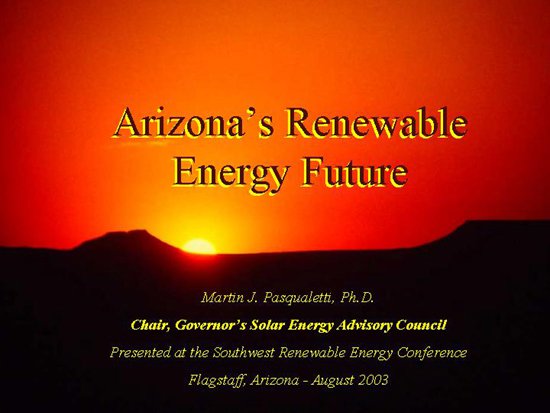Section 5. General devices/systems descriptions
5.1 General types of devices and systems which can be sold/installed in Arizona if they conform to specifications in this document (note: these devices also qualify for applicable State tax incentives):
a. Solar domestic water heating systems (covered in section 2) -- collectors, storage tanks, heat exchangers, and piping, valves, wiring, etc. directly related to the solar system.
b. Solar swimming poll and spa heating systems (not covered in guidelines; these devices are not required to meet any State specified certification, ratings or standards at the time of the adoption of these guidelines; therefore, they can be sold/installed in Arizona. However, they must meet any required Federal, local or other codes, standards, certifications, or other requirements, if applicable -- UBC, NEC, UL, etc. . . ) --- collectors, heat exchangers, and piping, valves, wiring, etc., directly related to the solar system.
c. Solar photovoltaic (PV) systems (covered in section 3) -- collectors, batteries, inverters, solar system related to wiring. Includes solar PV for RVs. End-use appliances (even if they are 12vdc) are excluded unless they are manufactured specifically for PV applications.
d. Solar PV phones, street lighting, etc (not covered in guidelines; these devices are not required to meet any State specified certification, ratings or standards at the time of the adoption of these guidelines; therefore, they can be sold/installed in Arizona. However, they must meet any required Federal, local or other codes, standards, certifications, or other requirements, if applicable -- UBC, NEC, UL, etc. . . ) -- collectors, batteries, inverters, solar system related wiring. Phone, light, etc. are excluded unless they are manufactured specifically for PV applications.
e. Solar thermal or electric space heating systems (not covered in guidelines; these devices are not required to meet any State specified certification, ratings or standards at the time of the adoption of these guidelines; therefore, they can be sold/installed in Arizona. However, they must meet any required Federal, local or other codes, standards, certifications, or other requirements, if applicable -- UBC, NEC, UL, etc. . . ) -- collectors, storage tanks, heat exchangers, and piping, valves, wiring, etc. directly related to the solar system.
f. Passives solar building systems (not covered in guidelines; these devices are not required to meet any State specified certification, ratings or standards at the time of the adoption of these guidelines; therefore, they can be sold/installed in Arizona. However, they must meet any required Federal, local or other codes, standards, certifications, or other requirements, if applicable -- UBC, NEC, UL, etc. . . ) -- Trombe wall components, thermal mass, and components specifically designed for energy gains. Dual pane windows, low-e and other window coatings, etc. are specifically excluded.
g. Solar daylighting systems (covered in sections 4) -- those devices and systems specifically designed to capture and redirect visible solar energy while controlling the infrared energy (conventional skylights are specifically excluded).
h. Domestic solar appliances (not covered in guidelines; these devices are not required to meet any State specified certification, ratings or standards at the time of the adoption of these guidelines; therefore, they can be sold/installed in Arizona. However, they must meet any required Federal, local or other codes, standards, certifications, or other requirements, if applicable -- UBC, NEC, UL, etc. . . ) -- solar ovens, food dehydrators, water distillers and other domestic solar appliances. Those solar domestic appliances not specifically listed herein that meet the legislative description of 'solar device' (ARS 44-1761) are also included.
i. Solar thermal/electric power generating systems, including stand-alone and grid-connected systems (not covered in guidelines; these devices are not required to meet any State specified certification, ratings or standards at the time of the adoption of these guidelines; therefore, they can be sold/installed in Arizona. However, they must meet any required Federal, local or other codes, standards, certifications, or other requirements, if applicable -- UBC, NEC, UL, etc. . . ) -- includes parabolic trough and dish-Stirling applications.
j. Solar and wind-powered pumps (not covered in guidelines; these devices are not required to meet any State specified certification, ratings or standards at the time of the adoption of these guidelines; therefore, they can be sold/installed in Arizona. However, they must meet any required Federal, local or other codes, standards, certifications, or other requirements, if applicable -- UBC, NEC, UL, etc. . . ) -- collectors or windmills, structure, pump, pipes and other components directly related to the pumping system.
k. Wind generators (covered in section 3) -- windmill, structure, generator, batteries, controls, wiring and other components directly related to the wind generator. End-use appliances are excluded
5.2. General types of systems and devices which are not considered in the legislation or this document (note: these devices do not qualify for any State tax incentives):
a. Conventional plumbing components -- water softeners, drinking water systems, etc. even if they are provided (gratis or otherwise) as part of the system.
b. Conventional controls -- load controllers, programmable thermostats, etc. even if they are provided (gratis or otherwise) as part of the system.
c. Conventional heating/cooling systems -- air conditioners, heat pumps, evaporative coolers, furnaces (regardless of efficiency).
d. Conventional windows and window treatments -- dual-pane, low-e, shade screens, reflective and dark coatings, awnings, interior shades, drapes and blinds.
e. Conventional skylights.
f. Appliances (all voltages) -- refrigerators, lights, TVs, etc. unless they are manufactured specifically for PV systems.
g. Fans -- ceiling, reflective roof coatings.
i. Insulation (includes "outsulation") and radiant barrier.
j. Weather stripping, caulking.
k. Misting systems.
l.. Vegetation -- shade trees, shrub, grass.






































































 APS has several large photovoltaic (PV) systems in the desert outside Gila Bend, Arizona. They are now adding energy storage systems to some of these PV systems. There is a good article about these on ABC15.com
APS has several large photovoltaic (PV) systems in the desert outside Gila Bend, Arizona. They are now adding energy storage systems to some of these PV systems. There is a good article about these on ABC15.com






 Battery Storage Costs Drop Dramatically, Making Way to a New Era. A recent Rocky Mountain Institute (RMI) report continues to confirm that clean electrification through batteries is advancing at impressive rates. Very interesting report: Breakthrough Batteries- Powering the Era of Clean Electrification
Battery Storage Costs Drop Dramatically, Making Way to a New Era. A recent Rocky Mountain Institute (RMI) report continues to confirm that clean electrification through batteries is advancing at impressive rates. Very interesting report: Breakthrough Batteries- Powering the Era of Clean Electrification 

 Arizona Solar Center Mission- The mission of the Arizona Solar Center is to enhance the utilization of renewable energy, educate Arizona's residents on solar technology developments, support commerce and industry in the development of solar and other sustainable technologies and coordinate these efforts throughout the state of Arizona. About the Arizona Solar Center- The Arizona Solar Center (AzSC) provides a broad-based understanding of solar energy, especially as it pertains to Arizona. Registered
Arizona Solar Center Mission- The mission of the Arizona Solar Center is to enhance the utilization of renewable energy, educate Arizona's residents on solar technology developments, support commerce and industry in the development of solar and other sustainable technologies and coordinate these efforts throughout the state of Arizona. About the Arizona Solar Center- The Arizona Solar Center (AzSC) provides a broad-based understanding of solar energy, especially as it pertains to Arizona. Registered